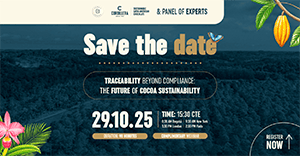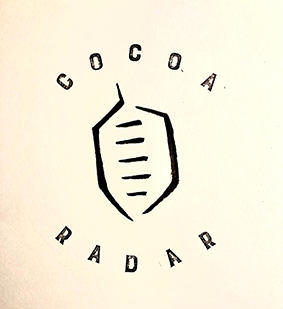This season’s chocolate sticker shock points to deeper pressures: a sharp drop in global cocoa supply, inflation-driven increases in packaging and transportation costs, and the knock-on effects of trade tariffs. While manufacturers and trade groups emphasise that demand remains strong, the high cost of cocoa means the premiums are likely to be passed on to consumers.
Meanwhile, the National Confectioners Association (NCA) is already looking ahead to 2030, forecasting growth despite current headwinds, suggesting the structural dynamics of the candy business may shift.
What’s driving prices up?
Even though cocoa futures prices have come down since the beginning of the month, according to a recent report by Wells Fargo Agri‑Food Institute, cocoa costs in the US chocolate supply chain have more than doubled since early 2024.
Analysts report that North American chocolate candy sales have been dropping by over 21% in recent quarters.
The root cause lies in the major cocoa-growing regions of West Africa — namely Cote d’Ivoire and Ghana, which together account for over 60% of global cocoa output.
Heavy rains in late 2023 and subsequent El Niño-induced droughts in 2024 triggered both black pod disease and increased incidence of cocoa swollen shoot virus disease, leading to a 12.9 % drop in global production to 4.37 million metric tons in the last crop year, creating a supply deficit of nearly 494,000 metric tons — the largest in over 60 years.

‘Reciprocal’ tariffs
In addition to crop losses, the US has imposed ‘reciprocal’ tariffs of 15-25% on major cocoa suppliers, including Ecuador, Côte d’Ivoire, the Dominican Republic and Ghana — adding further cost pressure on US importers and chocolate manufacturers.
Impact on consumers
Retail consumers are already registering the uptick. According to a CBS News report, an average box of 48 full-size chocolate bars has jumped from about US$40 to over US$50.
Still, surveys suggest Americans celebrating Halloween this year expect to spend more: one source cites an average of US$192 per person, up from US$172 in 2024.
The cost of candy alone, for those handing out treats, is estimated at approximately US$70.
According to the consumer price index for candy and gum, price growth of roughly 8% is being recorded, attributable primarily to the cocoa surge.
Impact on manufacturers and retailers
Many US chocolate makers are responding with strategies such as ‘shrinkflation’ — smaller package sizes at the same or slightly higher prices — and by reducing the variety of seasonal lines.
While some firms, such as Hershey, have publicly stated they will hold prices steady on Halloween-packaged items, analysts caution that this may reflect short-term positioning rather than a fundamental shift in cost pressures.
Wells Fargo analysts advise consumers to look for treats with lower cocoa content, generic brands, and to compare unit pricing across retailers if they are looking to stretch their candy budget.
Looking beyond Halloween
The high price of chocolate has implications for both consumers and industry:
- Consumer behaviour shifts: With elevated prices, some families may buy fewer treats, shift to non-chocolate candy or generic alternatives, or delay purchases. According to a report by Axios, 57% of respondents said higher prices were changing how much they spend on Halloween candy.
- Industry cost-push inflation: Chocolate supply is vulnerable — cocoa grows only in tropical zones — limiting the ability to offset local inflation or shift production. Supply disruptions thus have an outsized impact.
- Seasonal sales mix: Halloween is one of the “big four” confectionery seasons (alongside Valentine’s Day, Easter, and winter holidays) in the US. The fact that chocolate costs are running high at the moment may affect seasonal promotions, profit margins, and inventory decisions for retailers and manufacturers.
On the bright side
As a counterpoint to this year’s cost pressures, the NCA released forecasts earlier this month projecting the broader US candy market to reach US$27.8 billion by 2030 — driven primarily by growth in non-chocolate candy segments, younger consumers, and innovation in flavours and formats.
The NCA also notes that chocolate and candy are still viewed as “treats” — consumed 2-3 times per week on average by Americans — which supports the durability of demand despite current price headwinds.
Key pinch points - what to watch for:
- Crop outlook & weather: The next cocoa crop year has already commenced, but any further weather-related disruption to the main crop in West Africa could tighten supply further.
- Tariff/policy developments: Any changes to US import tariffs or trade deals affecting cocoa or cocoa-derived products could alter cost pressure.
- Retail behaviour: Will chocolate treat manufacturers keep raising list prices, shrink pack sizes further, or shift more aggressively to non-chocolate alternatives?
- Consumer substitution: If prices remain elevated, there could be a meaningful shift toward non-chocolate candies in the Halloween mix, especially among cost-conscious households.
- Long-term demand vs. cost: While the NCA sees growth ahead, if supply constraints persist, the ‘sweet indulgence’ may become less affordable for many.
CocoaRadar’s takeaway
For Halloween 2025, the deceptively simple act of buying chocolate for trick-or-treaters has turned into a more complex calculus. Behind the candy aisle lies a global supply shock, weather extremes, crop disease, tariff pressures and inflation.
While manufacturers and trade groups are holding firm that demand remains strong, the cost burden is real, and US consumers may find themselves paying more for their sweets this season.
At the same time, the confectionery industry is looking beyond the immediate crunch, betting that innovation, changing consumer tastes and generational shifts will propel growth through 2030.
For now, however, the message is clear: this Halloween, the treat might cost a bit more than usual—a scary thought.
- 'From Our Desk. To Yours. Daily.'
- Insights. Intelligence. Impact.
- Sign-up here for free and upgrade to an annual plan and support independent journalism.

